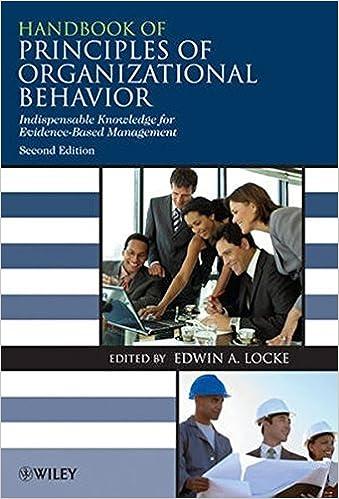To illustrate in real time a few creativity killers environmental factors that undermine creativity
Question:
To illustrate in real time a few “ creativity killers ” – environmental factors that undermine creativity by lowering intrinsic motivation – you will instruct students to make a creative drawing out of a scribble under tight time pressure, surveillance, constraint, peer competition, and unclear/meaningless goals, with external evaluation looming. This exercise takes 15 – 30 minutes and is best used at the very beginning of a workshop/class on creativity.
To run this exercise, first tell the class that they are going to take a short test of their individual creativity. Emphasize the word “ test ” during the instructions, and continue to remind them that their test will be evaluated – judged by their classmates according to a procedure that you will explain after the test. Tell them that this test is used for assessing artistic creativity, but is also a good indicator of their overall levels of creativity. Make sure that all class members have a blank sheet of paper and a pen or pencil. Have students draw a single, large scribble or squiggle on their page and then stop. Then, have students exchange their papers with another person near them and put their names on the new paper (which has someone else ’s scribble). Tell the class they will have two minutes to make a creative drawing based on this scribble and give it a creative title. Then give the signal for them to start. As students make their drawings, move throughout the room and look at students ’ drawings. In reality, give students somewhat less than two minutes ( perhaps 90 seconds), and announce how much time is remaining every 30 seconds when there is one minute left. When there are 30 seconds remaining, remind students to give their drawing a creative title. Count down the last 10 seconds aloud. Then say, “ Stop!
Pencils down! ” and have all students pass in their drawings. There is likely to be much nervous laughter among students during the exercise, and it is fine for you to maintain a pleasant demeanor. When drawings are being passed in, begin to make the atmosphere truly light and fun by inviting students to glance at the drawings as they go by.
After you have the drawings, begin by assuring students that their creations will not actually be judged, and that the reason for the exercise was to give everyone the same shared experience of trying to be creative on the same thing at the same point in time. Then debrief the class on their experience of creating something that was supposed to represent their true creativity, asking them to focus on any factors that made it difficult to be creative. Record their comments on the blackboard in three columns corresponding to the three creativity components. After taking comments for a few minutes (ideally waiting until the major work environment impediments have been mentioned), label these columns “ task expertise, ” “ creative thinking skills, ” and “ work environment intrinsic motivation. ” Emphasize that this task was not really a test of creativity, but a demonstration of what happens to intrinsic motivation and creativity when people are told to “ be creative ” in a work environment full of extrinsic constraints and extrinsic motivators. The debriefing should include a brief explanation of intrinsic motivation and the other two components of creativity, extrinsic constraints/motivators, and the intrinsic motivation principle of creativity. For an additional element of fun at the end of the class or workshop, spread out the drawings on an empty table for an informal “ art show.”
Step by Step Answer:






